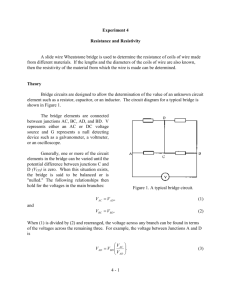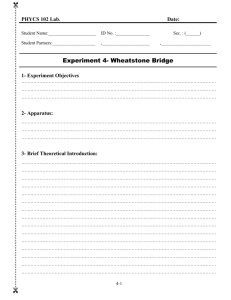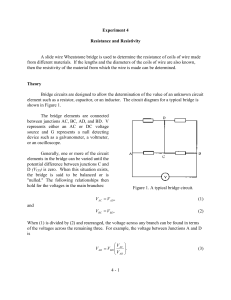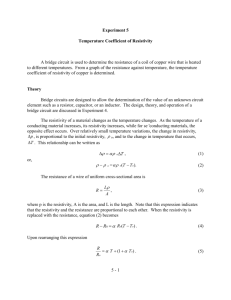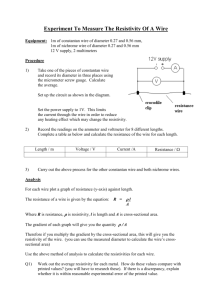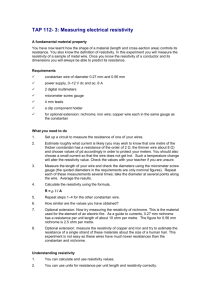Experiment 4
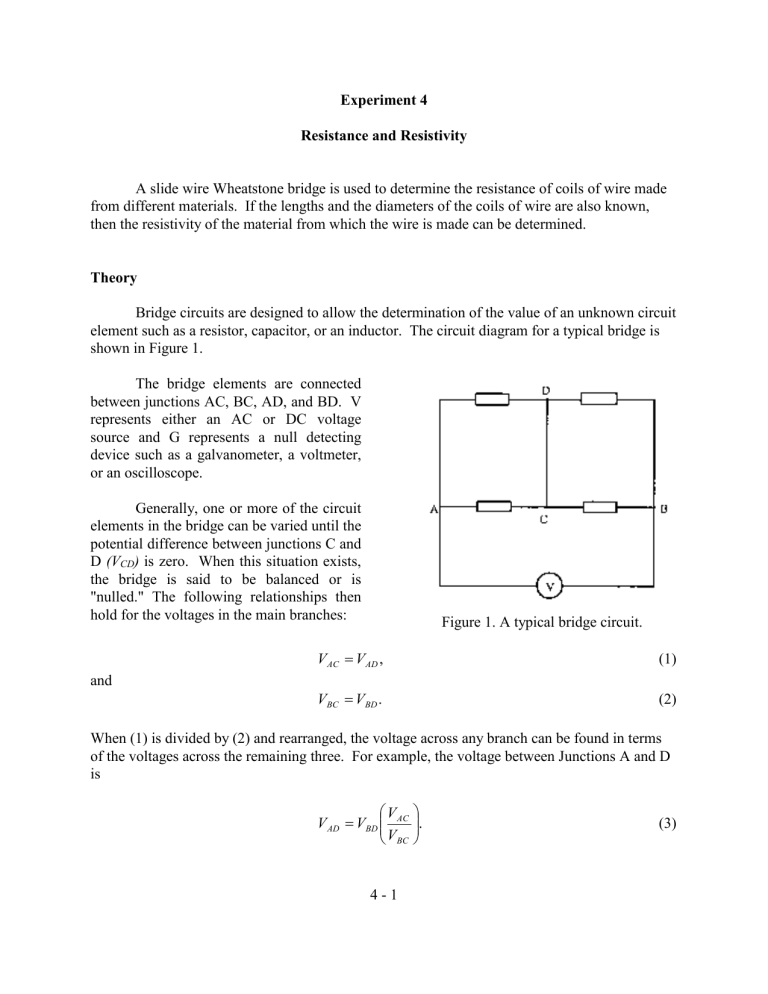
Experiment 4
Resistance and Resistivity
A slide wire Wheatstone bridge is used to determine the resistance of coils of wire made from different materials. If the lengths and the diameters of the coils of wire are also known, then the resistivity of the material from which the wire is made can be determined.
Theory
Bridge circuits are designed to allow the determination of the value of an unknown circuit element such as a resistor, capacitor, or an inductor. The circuit diagram for a typical bridge is shown in Figure 1.
The bridge elements are connected between junctions AC, BC, AD, and BD. V represents either an AC or DC voltage source and G represents a null detecting device such as a galvanometer, a voltmeter, or an oscilloscope.
Generally, one or more of the circuit elements in the bridge can be varied until the potential difference between junctions C and
D (V
CD
) is zero. When this situation exists, the bridge is said to be balanced or is
"nulled." The following relationships then hold for the voltages in the main branches:
V
AC
V
AD
,
Figure 1. A typical bridge circuit.
(1) and
V
BC
V
BD
.
(2)
When (1) is divided by (2) and rearranged, the voltage across any branch can be found in terms of the voltages across the remaining three. For example, the voltage between Junctions A and D is
V
AD
V
BD
V
AC
V
BC
.
(3)
4 - 1
The Wheatstone bridge is shown schematically in Figure 2. The coils of wire whose resistance is to be determined is connected between junctions A and D, and a known value of resistance is connected between B and D. A potentiometer or a long wire is connected between A and B with a tap at point C. The position of the tap can be altered, thereby, changing the resistances, R
AC
and R
BC
, on either side of point C. These changes then vary the voltage V
AC and
V
BC
.
Figure 2. Schematic of the Wheatstone bridge.
When the bridge is in the null condition (galvanometer reads zero), equation (3) holds.
Then a current flows from A to D to B (I
ADB
, and another current flows from A to C to B (I
ACB
) .
Knowing that the voltage across a resistor is IR (Ohm's Law), equation (3) can be expressed as
R
AD
R
BD
R
AC
R
BC
.
(4)
The value of R
AC is proportional to the length of wire L
AC
, and the value of R
BC is proportional to ( L
AB
– L
AC
) . In this experiment we are using a 100 cm long wire as a potentiometer so that L
AB
=100. If R
AD is the unknown resistance, and R
BD is the known resistance box value.
Equation (4) can now be written as
R x
R box
L
AC
100
L
AC
.
(5)
This is the working equation for the Wheatstone bridge.
The resistivity of the coil of wire with resistance R x
can now be determined. For a wire with a uniform cross-sectional area, the resistance is
4 - 2
R x
x
A
.
When this expression is rearranged,
AR x
x
, (6) where
is the resistivity, l x is the length of the coil of wire, and A is its cross-sectional area.
When the cross-sectional area is expressed in terms of its diameter, d, the expression for its resistivity becomes
d
2
R x
4 x
. (7)
The diameters of the unknown wires are given by the “gauge no.”: G# 22=6.439 x 10 -4 m; G#
26=4.049 x 10 -4 m; G# 28=3.211 x 10 -4 m.
Apparatus o wire slide apparatus o DC power supply o galvanometer o standard resistance box, ±0.2% o coil of copper wire o coil of German silver wire o coil of Nichrome wire o 5 leads
Procedure
1) Connect the Wheatstone bridge circuit with the standard resistance box between junctions B and D and the coil of copper wire of unknown resistance between junctions A and D. Record the gauge number of the wire coil and its length.
2) Turn on the DC power supply and adjust the voltage or current knob to some convenient value.
3) Set the tap at junction C to the 50 cm.
4) Depress KEY 1, 5 VOLTS button on the galvanometer. Pull and replace the plugs on the resistance box until the galvanometer needle is zeroed or nearly zeroed. Now depress KEY 2, 0.1 VOLTS button and again pull and replace the plugs until the needle is zeroed or nearly zeroed. Finally, depress the most sensitive button (KEY 3-
GALV) and again attempt to zero the reading by adjusting the resistance box.
4 - 3
CAUTION : If the most sensitive button (KEY 3-GALV) is depressed first, too much current may flow through the galvanometer causing it to bum out.
5) Hold the most sensitive button (KEY 3-GALV) depressed and slide the tap until the galvanometer is zeroed. If uncertainties are, to be calculated, then find the range of values of L that will zero the galvanometer. Record these values as L min and L max
.
6) Repeat steps (1) through (5) using the coil of German (nickel) silver wire. Repeat again with the Nichrome (Chromel) wire.
Analysis
Use (5) and (7) to determine the resistivity of copper, German silver, and Nichrome.
If uncertainties are to be calculated, then the value of L
AC in (5) is expressed as
L
( L min
L max
)
,
2 and its uncertainty is
L
( L max
L min
)
.
2
An estimate of the reliability of the resistivity values can be found using the “fractional uncertainty” method. Assuming that the length and cross-section of the wire are known to great accuracy, the uncertainty in the resistivity is due to the fractional uncertainties in R x .
The uncertainty therefore is given by
R box
R box
L
L
(
( 100
100
L
L )
)
, (8) here the uncertainties in the diameter and length of the wire on the coil are neglected. In (8),
L
=
L
( 100
L ) and
R box
/ R box
0 .
002 .
(Note that the standard resistance box has a tolerance of ±0.2%. If a different resistance box is used, then the fractional uncertainty of the resistance will be different.)
In a results table, report the experimental values of the resistivity for the three materials, their uncertainties (if calculated), the book values of the resistivities, and percentage errors when appropriate. Accepted resistivity values are: copper=1.72 x 10 -8 ohm-m; nickel silver=33 x 10 -8 ohm-m; nichrome= 100 x 10
-8 ohm-m.
4 - 4
ERROR ANALYSIS : Write a critique (no longer than a page) of the steps taken in this experiment to minimize errors. Were they adequate? Are there other practical steps that could have been taken to improve the results? Was there evidence of any systematic errors that could have been addressed? Be specific in your analysis and practical in your suggestions. Make quantitative estimates when appropriate. Use what you know. Exercise your best judgment.
CONCLUSION : Was the experiment a success given the purpose of the experiment? Justify your response.
QUESTIONS: Answer these in the most appropriate section of your lab report. Try not to repeat yourself.
NOTE : It is important that this be your report and not your partners. Identical answers or duplicated materials are considered plagiarism and will be penalized . It is acceptable to discuss the lab with your partners or other class members, but the final write-up should be in your own words and reflect your own thoughts and understanding.
1. In the theory section of the lab report write a complete derivation of the working equations of this lab. Use diagrams to illustrate your derivation. Make sure to define your variables and to justify your steps.
2. Derive the fractional uncertainty formula. If you need help, reread the “About Errors and
Uncertainties” handout in eCompanion.
3. Explain the limitations of a “voltmeter & ammeter” determination of a resistance value. Be specific with your explanation.
4. Explain how a “null measurement” (like the “zero” result in the galvanometer) can be made very precise.
5. Explain why
L =
(100 –L) in the uncertainty formula.
6.
The slide measurement should be made as close to the middle (50 cm) as possible. Explain the reason. You can demonstrate this by assuming that the uncertainty in the reading of the ruler is ±0.05 cm and determining the amount of uncertainty in the last two terms of the uncertainty equation for the case where L =10cm and comparing it to the case where L= 50cm.
7.
Briefly describe the microscopic (on the atomic level) processes on which resistivity depends. Why does the resistivity of conductors go up with temperature whereas the resistivity of semi-conductors goes down with temperature? You may need to do some “research” to answer this question.
4 - 5


